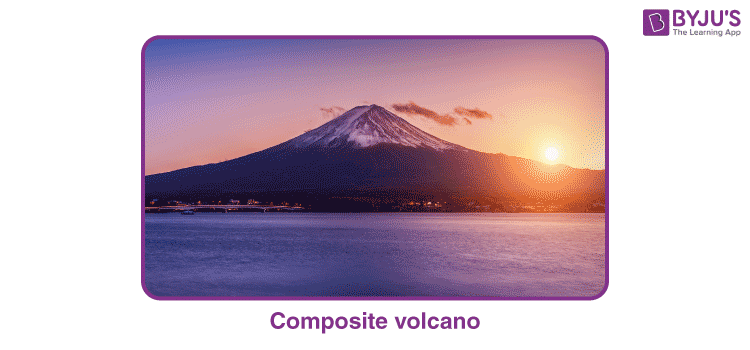We know that a volcano is a landform, a mountain, where molten rocks erupt through the surface of the planet. Eruptions of volcanoes take place when the pressure builds up in the earth’s crust. There are various types of volcanoes, they are: cinder cones, composite volcanoes, shield volcanoes, and lava volcanoes. In this session, let us know in detail about the composite volcano.
| Table of Contents: |
What is Composite Volcano?

A composite volcano, also known as a stratovolcano is a cone-shaped volcano built from several layers of lava, pumice, ash, and tephra. Due to its viscous lava, a composite volcano tends to form tall peaks rather than rounded cones. Mount Fuji in Japan and Mount Shasta in California are examples of composite volcanoes.
Structure of a Composite Volcano
A composite volcano may rise as high as 8,000 feet above its bases. Most of the composite volcanoes have a crater at the summit which contains a central vent or a clustered group of vents. The lava from the composite volcano is ejected through the breaks in the crater wall or from the fissures on the flanks of the cone. Solidified lava within the fissures acts as ribs that greatly strengthen the cone.

The conduit system within a composite volcano is one of the essential features of composite volcanoes. The magma from the deep reservoir of the Earth’s chamber rises to the surface through the conduit system of a composite volcano. Composite volcanoes are built up by the accumulation of material erupted through the conduit and increase in size as lava, ash, etc., are added to the slope.
| What is a Composite Volcano?
Composite volcanoes are steep-sided symmetrical cones of large dimensions that are built of alternating layers of lava, ash, pumice, blocks, and tephra. Examples of Composite Volcano Mount Fuji in Japan, Mount Cotopaxi in Ecuador, Mount Shasta in California, Mount Hood in Oregon, and Mount St. Helens and Mount Rainier in Washington |
Formation of Composite Volcano
A composite volcano is built over a span of thousands of years through multiple eruptions. The eruptions build the composite volcano layer by layer until the volcano towers thousands of metres. Some layers are of lava, while others might be of ash, rock, etc.
The conduit system which taps into a reservoir of magma deep within the Earth feeds the composite volcanoes. This magma erupts out of several vents across the composite volcano’s flanks, or from a large central crater at the summit of the volcano.
When a large composite volcano erupts, they create a collapsed region known as a caldera. Calderas are deep, steep-walled depressions and are the regions for a new composite volcano to build back again.
A composite volcano is formed along the Earth’s subduction zones where one tectonic plate slides beneath another. Pacific Basin and the Mediterranean Sea are such regions.
| What is a Volcano? | How does a Volcano Erupt? |
| Different Types of Volcano | Shield Volcano |
Characteristics of Composite Volcano
- The lava of composite volcanoes is composed of intermediate silica content and is of medium to high viscosity known as andesite.
- Composite volcanoes remain dormant for a long period of time. During this period, the solidified lava around the volcano’s vents collapses inside and blocks up its vents. This increases the pressure in the volcano, and the force of the subsequent eruption is immense.
- The lava from the magma chamber is ejected out of the composite volcano through the central vent. If the central vent is blocked, the lava exits through side conduits. These side conduits are known as fumaroles.
Life Cycle of a Composite Volcano
Here, we discuss the step by step process of the formation of composite volcanoes:
-
The Rise of Magma
Magma from the Earth’s chamber below rises to form a volcanic cone and erupts at the Earth’s surface through the conduit system. Lava flows and spreads over the surrounding area.
-
Active Volcanic Activity
The volcanic activities in a composite volcano continue for hundreds of years till a cone is built to a great height and lava flows form an extensive plateau around its base.
-
Eroding Cone
The volcanic activity ceases and erosion starts to destroy the cone. After thousands of years of volcanic activities, the cone is stripped away to expose the hardened “volcanic plug” in the conduit. During this period of inactivity, streams broaden their valleys and dissect the lava plateau.
-
Final Remains
The soil erosion continues removing all the traces of the cone. Now only the projecting plug, vestiges of the volcano and its surrounding lava plateau remain.
See the video below, to visualize and understand the volcano eruption.

Frequently Asked Questions – FAQs
What is a composite volcano?
A composite volcano is a symmetrical cone with steep sides that are built of alternating layers of lava, ash, pumice, blocks, and tephra.
Where are composite volcanoes most likely to form?
Composite volcanoes are most likely to form along the Earth’s subduction zones where the tectonic plates slide beneath each other.
Why are composite volcanoes steeply sloped?
The lava of the composite volcano is thick and cannot flow too far from the vent. Because of its viscous lava, a composite volcano tends to form tall peaks rather than rounded cones.
Are composite volcanoes the most common type of volcanoes?
Composite volcanoes are the most common type of volcano on the Earth’s surface. They account for 60 per cent of the Earth’s volcanism. Most of the remaining 40 per cent occurs under the oceans.
What are the examples of composite volcanoes?
Mount Fuji in Japan and Mount Shasta in California are examples of composite volcanoes.
To know about cinder cone volcanoes, stay tuned to BYJU’S and fall in love with learning!.
